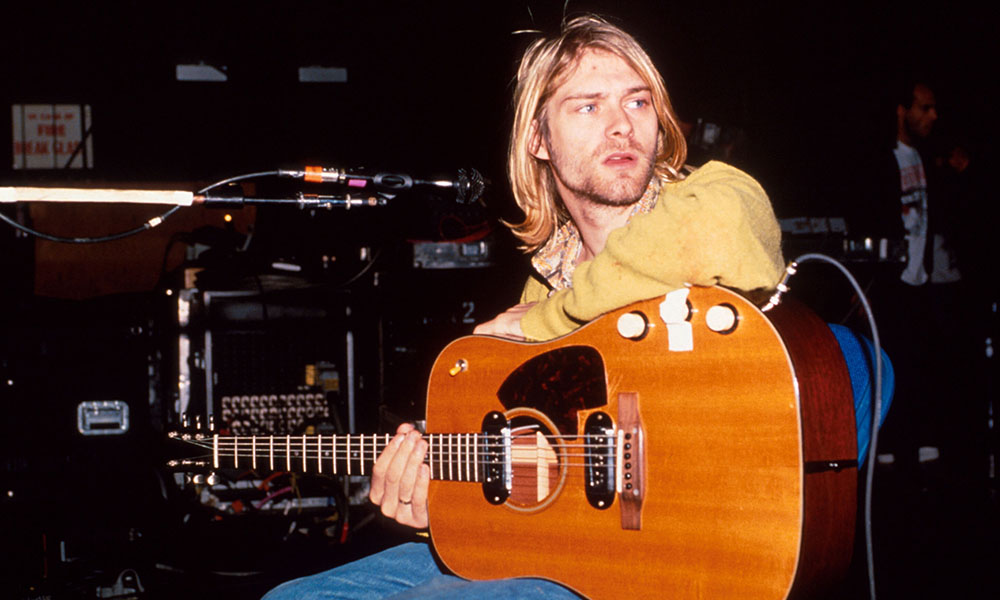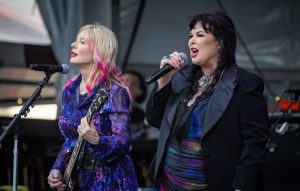The story of Nirvana‘s “Smells Like Teen Spirit” is one full of contradictions. Indeed, its very inception attested to the fervent dualities that tormented its author. In early 1991, as Nirvana prepared to work on their second album, Nevermind, guitarist and singer Kurt Cobain composed the song’s recurring riff, recognizing immediately its infectious qualities as befitting his intentions for this new batch of material.
Displeased with the oppressive, sludgy sound that had dominated their 1989 debut, Bleach, Kurt wanted to ensure that its follow-up would further expose the expressive moments that their debut harbored, allowing for songs with a stronger, more unabashed sense of melody than before. As well as being a champion of the uncompromising punk rock of Wipers and the primal power of Swans, Kurt was also a Beatles obsessive, and always sought to contrast his work’s prevailing darkness with an appreciable edge.
“[Kurt] had that dichotomy of punk rage and alienation, but also this vulnerable pop sensibility,” said producer Butch Vig, who’d be drafted in for this album’s sessions.
“All in all,” Kurt himself would later confess, “I think we sound like The Knack and The Bay City Rollers being molested by Black Flag and Black Sabbath.”
Writing Nirvana’s “Smells Like Teen Spirit”
His design for this particular song was far more ambitious than any nihilistic punk diatribe: he wanted to write “the ultimate pop song.” As he composed it, his mind was on the use of dynamics as employed by another influence, the Pixies, in particular their tendency of “being soft and quiet [in the verse] and then loud and hard [in the chorus],” Kurt would concede. “I connected with that band so heavily.”
Introducing it to his bandmates at rehearsal, it was deemed “ridiculous” by bassist Krist Novoselic, who despaired at being made to continuously play this “Louie Louie” rip-off for over an hour. Eventually, at Novoselic’s suggestion, the song’s pace was reduced, which allowed new drummer Dave Grohl (recently hired to replace Chad Channing) to throw in some “disco flams” inspired by funk drummer Tony Thompson. (This process is why it’s the only song on Nevermind in which all three band members are credited as writers.)
It was then crudely recorded onto cassette, which was sent to Butch Vig to notify him of this latest addition to the album’s pool. “It was so fucking distorted, I could barely hear anything,” Vig later recalled. “But underneath the fuzz, I could hear ‘Hello, Hello,’ melodies and chord structures. And even though the recording was terrible, I was super excited.”
The song’s lyrics
The lyrics on that recording were largely unfinished, and would only be completed once the band were in Vig’s studio. They’d got to Sound City Studios in Van Nuys, California, in May 1991, having stuck to their guns with the choice of producer, despite the objections of Geffen Records, the major label they’d just signed to after leaving the Seattle-based indie Sub Pop – a move spearheaded by Cobain that again pitched his ambitions against his punk rock ideologies.
Once complete, the lyrics seemed to corroborate the turmoil Kurt felt in dealing with his conflicting thoughts (“I’m worst at what I do best,” he sings), and while it infuriates him (“I feel stupid and contagious”), he resigns himself to his shortcomings (“Oh well, whatever, never mind”). He also famously included a relatively inscrutable line that has been misheard since its release. (“A mulatto, an albino / A mosquito, my libido.”)
Kurt’s words were seething with anger – aimed at himself and the world around him, which he viewed as banal and artificial. “I just didn’t get them the first time I read them,” Novoselic later said of the lyrics. “And then I started listening to it in the song format, and then I had an idea of what he was talking about. He was talking about kids, commercials, Generation X, the youth bandwagon, and how he’s really disappointed in it, and how he doesn’t want anything to do with it.”
After recording just three takes of the song, the second was chosen as the master, then, emboldened by double-tracked guitars and multilayered vocals (which Kurt had to be convinced to do by Butch Vig, who cited John Lennon’s tendency to do the same), became indomitably forceful.
The song’s title
The song title, meanwhile, retains its own paradoxical context. Not mentioned within the lyrics, the phrase dates back to the previous year, when during a night of drinking at Kurt’s apartment in Olympia, Washington, his friend Kathleen Hanna penned the immortal line ‘Kurt smells like Teen Spirit’ on his wall. It was a tongue-in-cheek reference to a can of deodorant spotted in the grocery store earlier by Hanna and her Bikini Kill bandmate Tobi Vail, an ex-girlfriend of Kurt’s. “I mean, who names a deodorant Teen Spirit?” Hanna said. “What does teen spirit smell like? Like a locker room? Like pot mixed with sweat? Like the smell when you throw up in your hair at a party?”
Despite its playful teasing, Kurt, who was unaware of the name’s origins, interpreted the graffiti another way. “I took that as a compliment,” he said, choosing it a year later to evoke the rebellious energy that fuelled his ode to the alienated.
“It has revolutionary themes, but I don’t really mean it in a militant [light],” Kurt would later say of “Smells Like Teen Spirit.” “The generation’s apathy is getting out of hand. [I’m] pleading to the kids, ‘Wake up!’”
Nirvana’s management didn’t identify with the song’s rallying cries, and therefore weren’t invested fully in its release as a single until it was delivered to college radio in August of 1991. Their expectations were soon to be confounded; “Smells Like Teen Spirit” went into heavy rotation, and then things got even bigger.
“‘Teen Spirit’ definitely established that quiet/loud dynamic thing that we fell back on a lot of the time. It did become that one song that personifies the band,” Dave Grohl said. “But the video was probably the key element in that song becoming a hit.”
The video for “Smells Like Teen Spirit”
After placing an ad for 18-25-year-old extras to appear in their music video (requesting that they “adopt a high school persona, i.e. preppy, punk, nerd, jock”), Nirvana filmed the video at GMT Studios in Culver City, Los Angeles, in a set resembling a high school gymnasium. Directed by Samuel Bayer, as the band plays to a spirited janitor and anarchy-loving cheerleaders, bored students are at first sitting subdued on bleachers. They then start to become more animated, rising to their feet, dancing and moshing before rushing the stage and trashing the band’s equipment while Kurt smashes his own guitar.
“People heard the song on the radio and they thought, ‘This is great’,” Grohl continued, “but when kids saw the video on MTV they thought, ‘This is cool. These guys are kinda ugly and they’re tearing up their fucking high school.’ So I think that had a lot to do with what happened with the song.”
The reaction to Nirvana’s “Smells Like Teen Spirit”
What happened was it went stratospheric. “Smells Like Teen Spirit” hit the Top 10 in the UK and US, while the album Nevermind reached Number One in the US and around the world. The video, meanwhile, won two MTV Video Music Awards and the critical acclaim was nearly unanimous. Grunge had arrived. Though these feats were unthinkable at the dawn of 1991, the chart stats became somewhat irrelevant as the song permeated and penetrated the mainstream until its stature attained almost mythical levels, eclipsing mere sales figures in its ascent to iconic greatness.
Kurt had succeeded in realizing his vision for “Smells Like Teen Spirit”; he set out to write a revolutionary anthem for the disenfranchised youth, and now he had an army of them looking to him for answers that he didn’t have.
At odds with its popularity, Cobain’s relationship with the song soured, and it would regularly be omitted from the group’s live performances. “It’s almost an embarrassment to play it,” Kurt said in 1994. “Everyone has focused on that song so much. The reason it gets a big reaction is people have seen it on MTV a million times. It’s been pounded into their brains. But I think there are so many other songs that I’ve written that are as good, if not better… But I can barely, especially on a bad night like tonight, get through ‘Teen Spirit.’ I literally want to throw my guitar down and walk away. I can’t pretend to have a good time playing it. Once it got into the mainstream, it was over.”
The song’s legacy
Decades after its release, “Smells Like Teen Spirit” remains as potent and exhilarating as ever. A regular contender in “Greatest Songs Of All Time” lists. In summer 2021 it surpassed a billion streams on Spotify. It’s also spawned countless covers by folks as varied as Malia J and Post Malone, and garnered a parody by Weird Al Yankovic. It was, ultimately, the blessing and curse that propelled Nirvana to a degree of fame that Kurt Cobain was entirely uncomfortable with. “I have my theories on why so many people connected to it and why Nirvana became a popular band,” Dave Grohl reflected in 2021, “but mine is just a little more distorted than an actual music critic.”
“It was a zeitgeist moment, you know?” offered Butch Vig. “It turned people’s heads. Those records don’t come along very often.”




